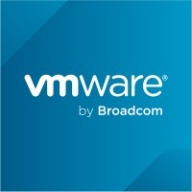![Cisco HyperFlex HX-Series [EOL] Logo](https://images.peerspot.com/image/upload/c_scale,dpr_3.0,f_auto,q_100,w_64/0dra2w8zbx5vrvwmhkdswx9l90ys.jpg?_a=BACAGSDL)

VMware vSAN and Cisco HyperFlex HX-Series compete in the hyper-converged infrastructure market. VMware vSAN appears to have a slight advantage due to its broader deployment options and strong integration with VMware products.
Features: VMware vSAN is known for its high performance, easy scalability, and strong integration with VMware solutions like vMotion and Distributed Resource Scheduler (DRS). Cisco HyperFlex HX-Series offers complete integration of computing, storage, and networking, providing high availability and a single platform for management.
Room for Improvement: VMware vSAN users desire enhanced management tools, better deduplication, and broader hardware compatibility. Cisco HyperFlex HX-Series users suggest improvements in integration with cloud platforms, better documentation, and pricing optimization.
Ease of Deployment and Customer Service: VMware vSAN provides broader deployment options, including private and hybrid clouds. It offers good technical support, though response times could improve. Cisco HyperFlex HX-Series has responsive support and is well-regarded, though users report mixed experiences with licensing and customer service.
Pricing and ROI: VMware vSAN is considered expensive due to licensing tied to CPU cores, but provides long-term cost savings and significant ROI. Cisco HyperFlex HX-Series also has a high initial cost, increased by subscription fees, but justifies the expense through comprehensive integration and operational benefits.


| Company Size | Count |
|---|---|
| Small Business | 24 |
| Midsize Enterprise | 17 |
| Large Enterprise | 57 |
| Company Size | Count |
|---|---|
| Small Business | 100 |
| Midsize Enterprise | 58 |
| Large Enterprise | 129 |
The Cisco HyperFlex HX Data Platform is a purpose-built, high-performance, scale-out file system with a wide array of enterprise-class data management services. The data platform’s innovations redefine distributed storage technology, giving you complete hyper-convergence with enterprise storage features:
VMware vSAN is a software-defined storage product that is used in collaboration with VMware ESXi hypervisor and that provisions and manages storage based on policies, regardless of the underlying hardware. The solution enables you to prime your business for growth through its seamless evolution (it is integrated with vSphere and requires no new tools), its flexibility, and its multi-cloud capabilities. As an industry-leading software, VMware vSAN provides high levels of performance with minimal impact on CPU and memory.
VMware vSAN Features
VMware vSAN has many valuable key features. Some of the most useful ones include:
VMware vSAN Benefits
There are many benefits to implementing VMware vSAN. Some of the biggest advantages the solution offers include:
Reviews from Real Users
Below are some reviews and helpful feedback written by PeerSpot users currently using the VMware vSAN solution.
PeerSpot user Yves S., CEO, Cloud Evangelist at Comdivision Consulting GmbH, says, “vSAN gives us a lot of advantages when we need to expand resources. We have an overall larger host infrastructure, and we split that up for specific customer test and use cases. In that specific scenario, we can easily add more hosts or reduce the number of hosts in the environment.”
A reviewer who works in Infrastructure Security explains, “The ease of use is great. The initial setup and upgrade process was pretty straightforward. And, technical support is great.”
Laurent N., Director at Softlogic, comments, "The feature that I have found most valuable is that it is easy to deploy. It is easy to create and delete virtual servers. It is easy to create the load balancing and the clustering."
We monitor all HCI reviews to prevent fraudulent reviews and keep review quality high. We do not post reviews by company employees or direct competitors. We validate each review for authenticity via cross-reference with LinkedIn, and personal follow-up with the reviewer when necessary.